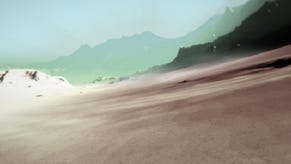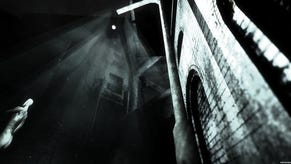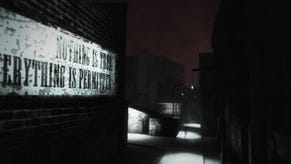Bug Powder Lust: Destination Tangiers
Going Dada
This is the latest in the series of articles about the art technology of games, in collaboration with the particularly handsome Dead End Thrills.
It's not every day you find yourself nodding to every comment under a news story, to the point of trolling yourself. But if we pretend for a minute that my buddy's mother does indeed make $68 an hour on 'the internet', that's precisely what happened when Adam raved about the latest screenshots of Tangiers on Monday. Much as it does look like a stealth game dialed into the furious dystopian frequencies of Lynch, Burroughs, and Cabaret Voltaire, it also kinda looks like a bunch of Dutch angles and Instagram filters slapped on a load of warehouses. Then again, what else should the videogame Videodrome look like?
Maybe Tangiers will be this year's answer to The Void. Maybe [twirls moustache] it'll be this year's answer to Thief, eh?? And maybe you'll grow a controller-shaped tumour about two months after you've finished it that unlocks the DLC. For answers to none of these questions and more, here's Andalusian lead Alex Harvey.

DET: Stealth would be the obvious choice for a game with such a stark look as Tangiers. Was it?
Alex Harvey: Tangiers didn't actually start off as a stealth game - its origins lie in what was a very fast-paced, very casual bullet hell game. A sort of cross between Hotline Miami, Assault Android Cactus and Deus Ex. Pick-up-and-play, very controller-based. You'd use the shoulder buttons to shape-shift your character on-the-fly; you had the choice of permutating between ranged, melee and stealth archetypes. Running around, jumping off of walls, changing strategy with a rock, paper, scissors approach to different enemies.
I originally just wanted something very disposable, a quick bit of fun that would take just shy of a year to develop. Something to say, 'Hello, I'm a game dev.' That ended up evolving into Tangiers, mostly driven by, as you say, the aesthetic.
Visual tests started veering in the direction of what we've got today, and it became clear that my original concepts for the game would have been wasted with what we were heading towards. Not to slag off arcade type games: Assault Android has been one of my favourite games recently. So, we took a step back to reassess, just playing with the visuals, with potential environments: what can we evoke with them? And so we edged towards the potential of an emotive journey of vulnerability, of detatchment. Naturally that left a nice, stealth-sized hole for the gameplay to slot into.
DET: Did you ever consider making the game more of an art installation or interactive fiction - something that would free your hand when it came to visuals?
Harvey: We never wanted Tangiers to become an art installation. In fact, there's been a conscious drive to move it away from what's normally seen as 'art games', from Proteus, etc. I've always found that form of game somewhat unsatisfying, personally. I want to pick up the controller or the mouse and keyboard and enjoy something that offers a fairly low-level, primal satisfaction. If there's a level of depth and creativity - a conversation, you could say, between the designers and the player - then even better. I'll invest myself in it.
Moving around a comparatively static environment and feeling someones 'idea' doesn't pay off for me. It never feels earnest enough. It's a dissatisfaction that I think is similar to Antonin Artaud's approach to theater, of the artifice of bourgeouis, 'civilised' entertainment. Stealth, on the other hand, is violent on an expressive level.
Of course, there's a degree of contradiction in what we're doing. There's plenty of installation-type feeling as the player moves through the landscapes. It's a balancing act. Where we have our dreamscapes, I try to execute those in the context of the game as what would be performed in cinema as slow camera shots. Tarkovsky-type cinematography, albeit through gameplay.

DET: There's a lot of psychological trickery in the screenshots: Dutch angles, impaired vision, extreme FOV, vignetting… Are these indicative of the finished product or more conceptual?
Harvey: All in the style of the finished game, using the same post FX setup that the player will be looking through. Things like the Dutch angles are coded into the player camera - though, with the inevitability that it'll piss some people off, there's a slider to tone it down in the options. Like you said, it's psychological tricks. Playing with the idea of the camera view - and world aesthetic and fidelity as a whole - partly representing the character's perspective, a passive form of characterisation.
DET: The guys behind Betrayer capitulated somewhat when players complained about the look of their game. Are you more defiant?
Harvey: Some people might not like the soft focus, the stylisation… I guess the game's not for them. Would it be irritating in-game? There's a lot of effort put in to ensure that it doesn't actively impede the gameplay. For example, there's lots of carefully placed ambient lights to ensure that spacial awareness is suitably maintained in spite of there being some very dark, pitch blacks.
DET: Some of the early screenshots - the Naked Lunch-evoking shot of the apple-headed corpse springs to mind - are conspicuously rough in terms of assets. Is any of that deliberate?
Harvey: Partly. We've got a lot of rough edges in the game that I'm happy to have in there. It's a fairly impressionist art style overall; a dodgy bit of texturing here, a slightly low-poly character there... those are the brush strokes, the imperfections, the film grain. We're taking a lot of influence from how games such as Morrowind or Pathologic express themselves without taking advantage of fidelity, even by today's standards.
Still, I get slightly awkward when putting out new shots. Inevitably, everything has some slightly rough assets in. I worry that in one shot the imperfections are masked, but on a later one they're not and that people will feel short changed, like there's a facade that's slipped away. The apple-headed corpse was kind of a warning: I wanted something fairly prominent for the Kickstarter campaign that made clear the rough underlying nature of the game, that would avoid anyone feeling ripped off. Fortunately, we've improved ourselves. There's nothing quite so shonky in there any more.
DET: Stealth games tend to metamorphose whenever daylight's involved, and not always for the better. How does Tangiers adjust to those outdoor landscapes?
Harvey: It's a very deliberate split, one which will often be quite jarring and not entirely popular with everyone, but it's a somewhat confrontational approach which I think is necessary. It gives us a fairly violent emotive tool to put upon the player. You spend prolonged periods within these suffocating, dark, near monochrome urban regions - hostile environments where a misstep will get you killed. Then we tear it away, leaving players in the middle of a brightly lit, directionless nowhere. Different types of vulnerability, all contributing to the journey that we're trying to create.
DET: You mention Dada a lot. Some might worry that gaming's lost its ability to shock on any meaningful level. Do you plan to put that to the test?
Harvey: There's a big insecurity here. Creating something that is 'shocking' and has people tweeting and writing articles about it, that's easy. You often see it done quite inadvertantly or hamfistedly, such as with Hotline Miami 2.
We're going to be cutting close to the edge in a lot of places. We name-drop Burroughs enough that we're practically obliged to do so. It's just making sure that we get our aim right, that we'll have the harsher, grotesque moments but executed in a manner that's got appropriate weight and meaning behind it. Audience reaction is a big part of expression, so getting that right is so important. Insecurity is both hamming it up and having it overshadow what we want to do. Such a concern in itself runs contrary to the Dadaist principles we hold dear.
DET: You seem to view the avant-garde as a movement full of strong references and homages, and have built Tangiers accordingly. Would that explain things like the PWEI lyrics on the walls?
Harvey: Yeah, there's a degree of wanting to be honest and explicit about our influences. It's very much a composite world we're creating, a track built from sampling a hundred other people. Sample it, loop it, fuck it, eat it and spit it out was one of PWEI's refrains - something that forms a big part of our approach to the game's design and setting. Words on the wall helps drive this home, ties in with idea of cut-up and photomontage, and gives this fairly unique texture to the setting.
DET: With Burroughs in mind, the game's title almost demands we talk about drugs. Literature reveres drugs and addicts while games barely acknowledge their existence. Why is that?
Harvey: There's almost too many angles we could approach that from. You've got the stereotypical triple-A power fantasy inherent in a lot of games' characterisations; the difficulty that the young, somewhat naive medium has in telling stories that rise above the quality of daytime TV; and the generally limited scope that gaming has in terms of influences. Oh, and of course the implicit level of 'fun' that the concept of gaming evokes runs oblique to harder stories.
You could write an essay for each issue and more, and while none can be blamed entirely, it leaves us with a narrow field of opportunities in which such a topic can be adequately expressed. From a player perspective, there's the lack of control instigated by addiction that would prove difficult to navigate. Another hurdle.
It'll change, though. It is changing. A decade from now, post Gone Home, etc, with a far lower bar of development entry, a far broader scope will be commonplace.
DET: One of the advantages of more surreal or twisted art styles for the indie is that is spares them the horror of modeling and animating real people. Does Tangiers enjoy that luxury, and was that the reason?
Harvey: Simply put, a big criteria in creating the style of Tangiers was that it would help keep the workload manageable. The rough, sketchy, inhuman, corpselike, doll-like inhabitants of Tangiers are not just derived from necessities of the setting, but necessity of resources. Choices in the art direction allow us to manage suspension of disbelief in a world pulled off with conviction.
That's also part of the reason why everything is low fidelity. We could create smoother character models with a bit more detail quite easily, but then we run into uncanny valley territory. If a character has a lot of detail but the detail is static, the whole illusion collapses.
DET: Are you resisting the lure of glitch art?
Harvey: I've gotten quite the soft spot for glitch art lately. There's a short game, Фùþç [pronounced 'fooths'], that introduced me to it. I like the aggressive potential of glitch, that free-form fucking with things. Noctuelles [coincidentally the next of these features] have a game in development at the moment, Hunting Anubis. The glitch is somewhat controlled in there, but it's the most beautiful thing I've ever had running on my computer.
We've got a sort of glitch art in Tangiers with our cut-up, an almost straight replication of Burroughs or Dada. The game takes a semi-procedural approach to distorting future levels based upon past actions, inserting fragments of previous areas. It's got that destructive nature of glitch but it's a little more targeted. It affects the in-game reality but doesn't scratch at the fourth wall in the way glitch does.
DET: Audio is a critical component of player manipulation. How would you describe the soundscape of Tangiers?
Harvey: Very sparse and sample-driven. To be descriptive on a purely technical ground, we use lots of periods of silence or at least very low, subtle drones to allow the environmental audio to come through. But there's a certain blurred lines approach that we're taking to diagetic/non-diagetic audio. A large portion of the actual music is being made up of distorted and warped, location-appropriate found sounds. Similarly, diagetic audio is being distorted slightly to fit in with the soundtrack. Footsteps almost sounding like percussion. Stylistically that gives us a blend of early-industrial influenced ambient for the most part, switching in to a sort of low-tech, dark and fragile trip-hop where appropriate. Outside the ambient, we're aiming for an almost 'Cabaret Voltaire does Massive Attack' approach.
In terms of it having emotive resonance, we're allowing the music to grow alongside the world design. Not a case of 'here's an area, put a score to it'. As we build up the larger areas, we incorporate the audio development into our weekly design meetings. Laying out exactly what an environment is trying to achieve, how we're going about that and so on. Build up the physical off of this brief while the audio gets done, meet a week later, and share ideas. The audio affecting, guiding the world and then the physical returning the favour.
DET: How comfortable are you with Unity now? Comfortable enough to be frustrated by any of it?
Harvey: A healthy amount of frustrations, but the majority of them are just me being crap; in terms of technical proficiency I'm probably at the lower end of the scale. I can get by and achieve some really nice things in the engine, but generally only after hitting my head on the wall for prolonged periods. Overall I'm confident, though, and all of our tools are actually far better than they were pre-Kickstarter. I think that's visible in a lot of our newer screenshots, in particular the landscapes.

DET: How long do you think Tangiers should be, and are you the sole deciding factor in that regard?
Harvey: We're aiming at a game that if you go through it at a fairly comfortable pace - explore a little bit - will take maybe 8-10 hours on the first go. A little bit short, I'm sure some will say, but resources are a big thing here. With the sandbox, immersive sim approach we're taking, almost every area will have multiple approaches, little pockets to explore, alternate routes. It may be a short, five-minute segment to the player, but for us we've got to build 15 minutes' worth of gameplay.
We could stretch it out, put in some uninteresting filler areas to pad the game, but I'm not interested in that. I want something that's constantly satisfying and rewarding.
DET: If all goes to plan, what legacy do you want for Tangiers?
Harvey: If everything comes out as I envision it and it clicks with gamers, I'd like it to have a fairly lasting, albeit minor legacy. Something that sticks in people's minds and inspires as a creative entity in a similar way to Ice-Pick Lodge's games - sans bugs and dubious translations, of course! Talking about future success is often seen as unfashionable or a bit of a faux-pas, but that's what I think we have the potential for.










